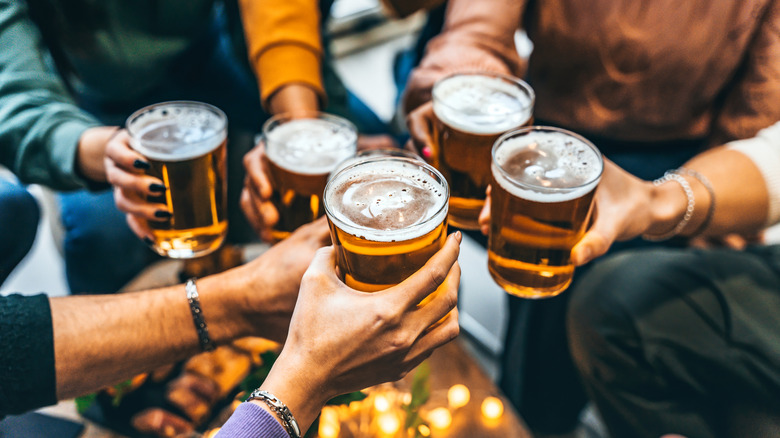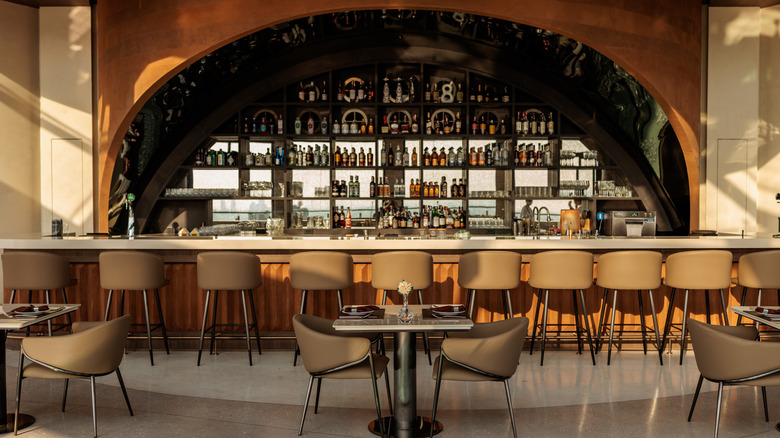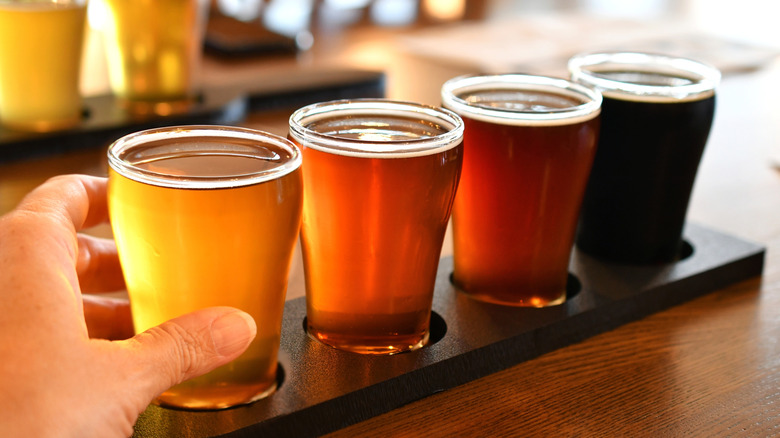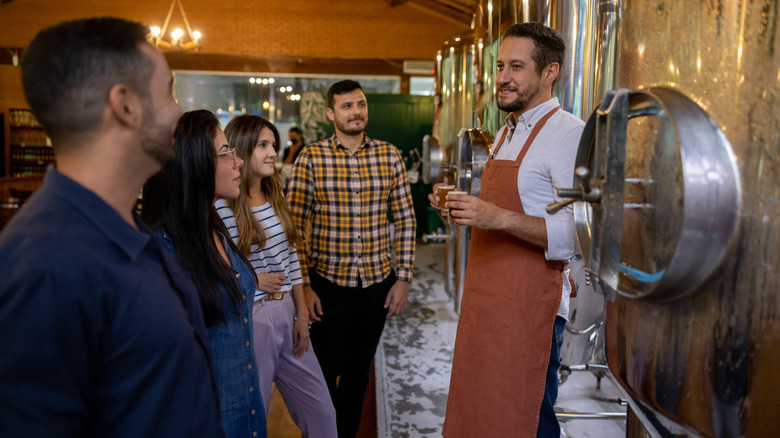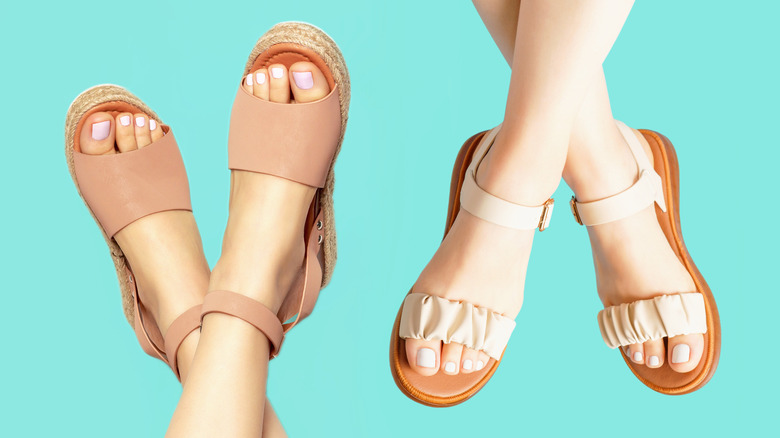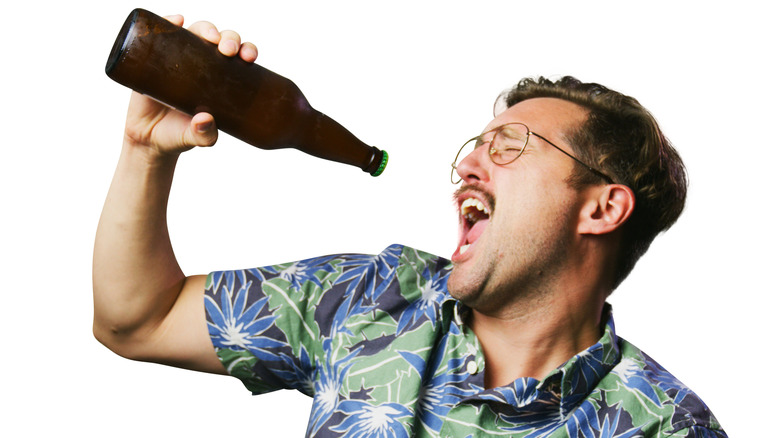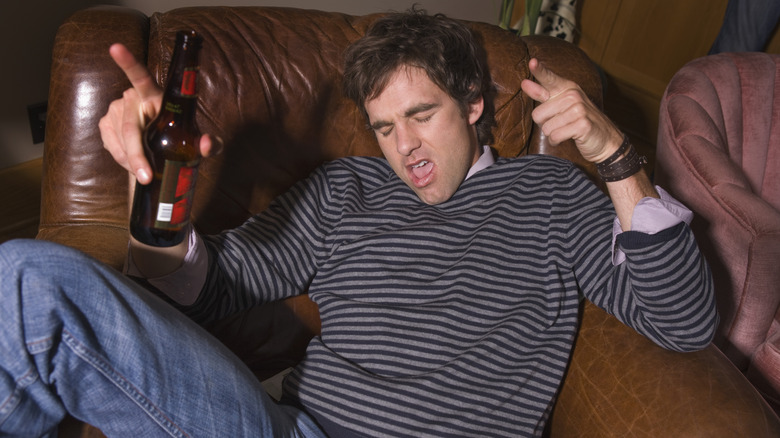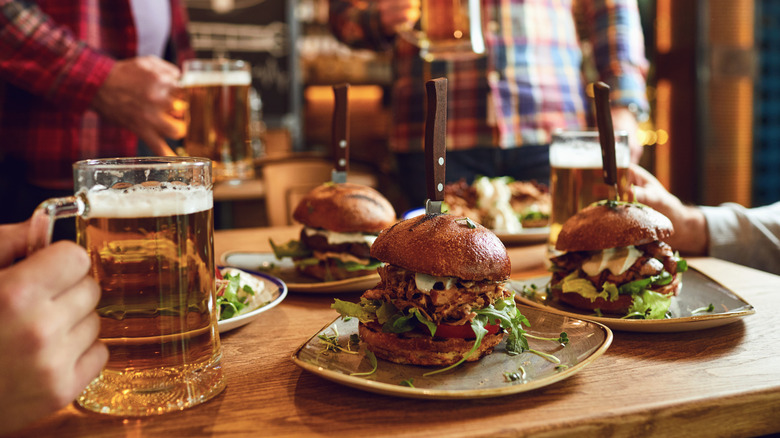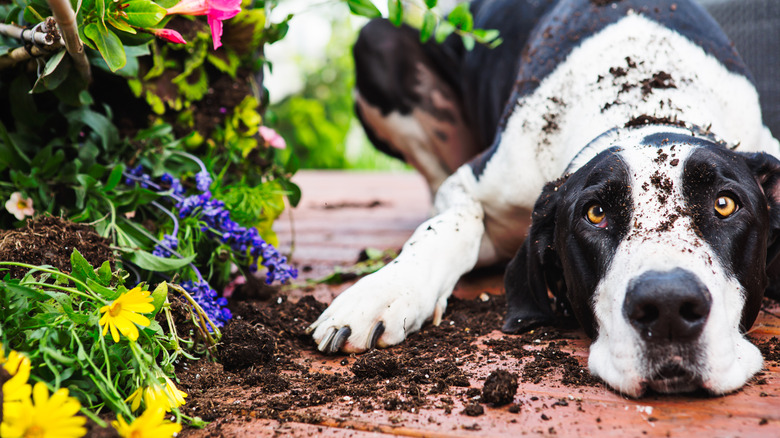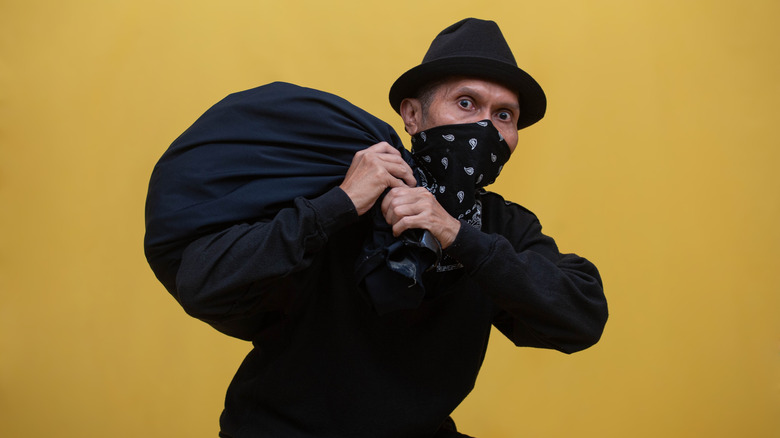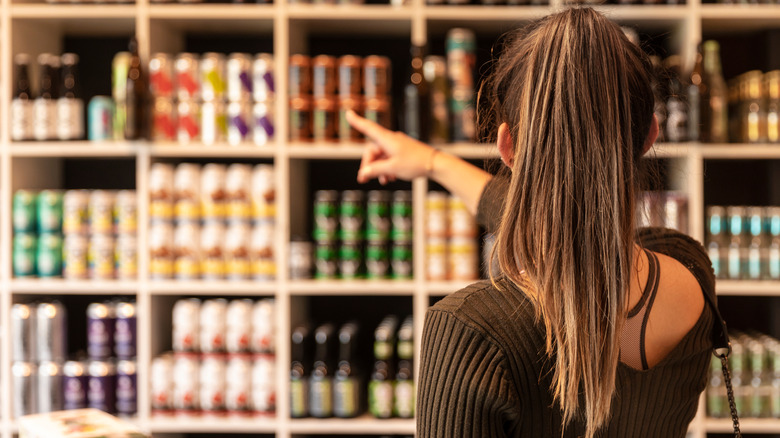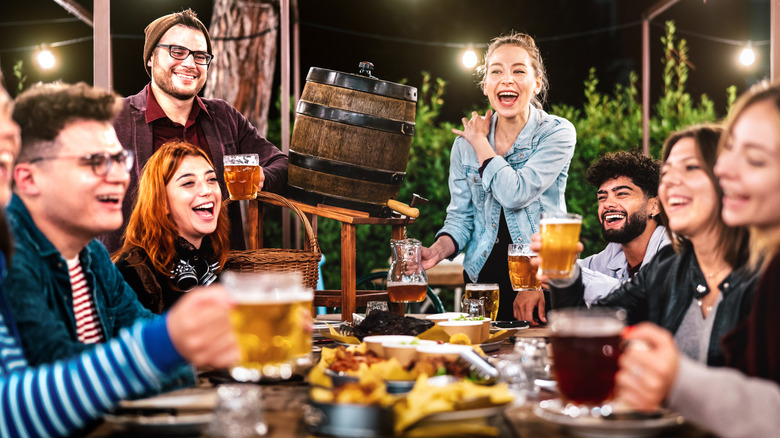12 Mistakes To Avoid When Visiting A Brewery
Humans started brewing beer around 7000 B.C., thousands of years before the wheel was invented. Since then, empires have risen and fallen, and we've left footprints on the moon, yet breweries remain an integral element of our social fabric. Despite this long history, they remain a mystifying domain for some people, and there are common mistakes repeated by visitors. We spoke with Carissa Knapp, a representative of Common Space Brewery in Los Angeles, to learn what these mistakes are and how an informed visitor can avoid them. We combined these insights with our own research and experience to bring you a comprehensive guide to avoiding common pitfalls.
"Brewery visits are all about the experience," Knapp said. "Good vibes, good people, and good beer." A few minutes of planning and research will ensure you get the most out of your next visit. These tips will tell you what to look for, then get out and visit one of the 9,796 craft breweries the Brewers Association estimates are operating in the U.S. Because, as Albert Einstein said, "Knowledge is experience; everything else is information."
Confusing a brewery with a bar
The first mistake to avoid is confusing a brewery with a bar. Although they may share common characteristics, they are distinct businesses. The primary difference is that a brewery produces its own beer, while bars serve alcohol made in other places. Don't make the mistake of walking into a brewery and ordering a Coors Light, unless you are visiting the Coors brewery in Golden, Colorado. Also, don't expect to find spirits and mixed drinks. Not only are breweries primarily focused on featuring their own creations, but they also usually operate under a license that doesn't allow high-proof products.
Technically, the public-facing section of a brewery that serves beer is called a taproom. The atmosphere of a taproom can vary wildly from brewery to brewery, but it is a place to showcase the beers made on the premises. Like a bar, many breweries, including Common Space, provide entertainment such as televisions tuned to sporting events, trivia nights, and comedy shows.
Unlike a bar, the staff in the taproom are usually closely connected to the product they are serving; think of it like tableside service from a chef. Especially in a small craft brewery, it could be the brewmaster operating the taps. Keep this in mind. Using phrasing like, "this beer isn't for my taste" can prevent the awkwardness of telling a passionate brewmaster that "this beer isn't good."
Not asking questions
Another mistake is bottling your curiosity. One of the top tips Carissa Knapp provided was to ask questions. "Our friendly team loves talking about beer," she said. "Whether you're curious about hops, brewing, or what pairs best with tacos, just ask."
The same advice was echoed by other brewers as well. A website dedicated to Pennsylvania craft breweries talked to 11 local brewers to get their tips for visitors; more than half encouraged questions. "If you're deciding what to try and it's your first time there, ask for a recommendation," said Courtney Costa, head brewer at Meyer's Brewing Company in Philadelphia. "Most brewery staff are really excited to talk about their beer and will tell you the must-tries."
Don't limit questions to beer recommendations. Jeff Stuffings, owner of Jester King Brewery in Austin, told craftbeer.com he wished more people would ask about the laws and regulations that breweries have to navigate. Doing so will not only allow you to learn about the unique challenges of running a business in this industry, but you also might pick up a tidbit that comes in handy on trivia night. For example, you could learn that in Alaska you will find fresh beer in the taproom, but you won't find televisions, pool tables, or dancing since state law bans live entertainment. Or, that New Hampshire consumes the most alcohol in the nation, but until August 2025, it was illegal to carry a beer into the restroom.
Neglecting to order a flight
In brewery lingo, a flight is a collection of small pours that let you sample a variety of offerings without guzzling a full mug of each. It typically consists of three to five small glasses that roughly add up to a pint. "It's the best way to explore new styles and find your favorite," Carissa Knapp said. The flight is usually served on a small tray and arranged in the suggested sampling order — which is important, because drinking a hoppy double IPA will numb your taste buds to the more delicate flavors of a pilsner. The bartender knows the best order for their specific offerings, but the typical approach is to start with the lightest beers, move to hoppier pours, and end with the darkest brews.
Flights are great for non-beer drinkers and connoisseurs alike. "Step out of your comfort zone," Knapp suggested. "There might be a beer that surprises you." For a non-beer drinker, or someone that mostly drinks light beers, that might mean adding a fruity IPA or an imperial stout to the sampler, but the opposite is often true for a seasoned craft beer drinker who gravitates toward the wild creations. "Light styles are much more challenging to nail," said Rob Tarves, co-founder of Our Town Brewery. Sampling a pilsner, kolsch, or cream ale is a chance to see how the brewer performs without bold flavors to hide behind.
Skipping the tour
The brewery tour is an excellent opportunity to go behind the scenes and see how the operation works. Every brewery is unique. Some are obsessed with brewing the world's strongest beer, while others might focus on perfecting a specific style. The brewery tour is where you will hear the backstory and find out what drives the passion of those particular brewmasters.
As a bonus, most tours include a sample of the product. Sometimes, it even includes unique pours that are only available in limited quantities, and therefore not available for the general public. These tastings are similar to ordering a flight, but with an expert on hand lending a personal level of insight that a busy bartender wouldn't be able to. At a minimum, it's an opportunity to see the production facilities and learn about the brewing process. Plan ahead; tours are typically only offered at certain times and require advance reservations.
Wearing the wrong shoes / clothes
When it comes to fashion, it's hard to wear the wrong thing to a brewery. It tends to be a laid back environment that shares a dress code with corner stores, meaning if you're wearing a shirt and shoes, you can get in. From there, it's hard to be over- or underdressed. Common Space plays Dodgers games and also hosts weddings. Go on the right night, and you can find baseball jerseys and tuxedos.
Functionally, it is possible to wear the wrong outfit, especially if you are planning to take a tour. One of the first things you will realize on a tour is that brewing beer is an industrial endeavor. The production facilities are typically in a warehouse filled with large tanks, forklifts, and other manufacturing materials. For safety reasons, many breweries don't allow open-toe shoes on the tour. Even if you aren't taking the tour, it's important to keep in mind that many taprooms could easily be described as rustic. As a rule of thumb, dress comfortably for the climate and wear closed-toe shoes for the tour. Don't let your outfit derail the experience.
Thinking breweries are just for beer nerds
Some people avoid visiting breweries because they think it is just a place for beer lovers to pontificate about hops and malts. That's a mistake. "We wish more people knew that you don't have to be a beer expert to enjoy a brewery," Carissa Knapp told us. "We have something for everyone, including non-alcoholic options, local food trucks, and community events that bring people together."
Common Space isn't alone in offering an experience that appeals to a broad audience. Breweries around the nation find ways to connect with beer enthusiasts as well as those who are ambivalent about brewskis. Even a casual beer fan with a preference for mass-produced light beers is likely to find something they enjoy drinking and learn interesting facts about how beer is produced. But where things really get wild is when a brewery adds options that extend beyond drinking beer.
Live Oak Brewing in Austin advertises that they "make beer for people who like the taste of beer," but that's not the only draw — there is also an 18-hole disc golf course that winds around the property. Bube's Brewery first started operating in Mount Joy, Pennsylvania, in 1876. Today, it features a microbrewery, boutique hotel, and dining in the stone catacombs 43 feet below the surface of the earth. The brewery decided that the atmosphere, which they describe as "much like a fine Victorian home of the late 1800s," was ideal for murder mystery dinners, so they offer those as well.
Overindulging
Breweries pack the potential for too much of a good thing, and one of the ways for a visit to go south is by overindulging. It's important to pace yourself when drinking at a brewery; there is a reason they call it a tasting room instead of a chugging room. You'll get more out of the experience if you take time to sip the beer and savor the flavor and characteristics.
Intoxication is determined by your blood alcohol content (BAC). The sweet spot, or green zone, is a BAC of .06%, enough to experience the relaxation effects of alcohol while also staying beneath the legal limit and avoiding slurred speech or a staggered gait. The key is to allow your body time to process the alcohol that is being consumed. The amount of alcohol a person can process varies, but a general rule of thumb is about one alcoholic drink per hour. Consume more than this, and your BAC creeps up.
Other than controlling your pace, there is not a magic formula to avoid inebriation. But there are a few tips to keep you feeling your best. First, eat. We'll cover this more in the next section, but a full stomach helps absorb alcohol and keeps your BAC from spiking. Then, drink water. Drinking a glass of water between each brew will not only help slow your drinking pace, but also keep you hydrated and prevent you from needing Anthony Bourdain's hangover cure.
Forgetting to make a dining plan
Having a dining plan is a key pillar of the overindulgence strategy, since a full stomach helps absorb alcohol and keeps your BAC from spiking. Most breweries make this easy for you by having a kitchen or food trucks parked on the property. However, Murphy's Law decrees that if you don't verify that before you arrive, you are going to be disappointed. Check the food options during your pre-visit research, and don't make the mistake of assuming.
A dining plan can also elevate the tasting to a gastronomic event. Wine and food pairings get all the headlines, but there are beer aficionados who are happy to share tips, such as the best beer to pair with barbecue. Forget what your mom said: A brewery is a place to play with your food. Try beers with different foods and see how the flavors are impacted. If you have a flight, experiment to see how different beers complement the food. It's an opportunity to add another dimension to the tasting and another way to focus on the flavors.
Mistaking a brewery for a dog park or a playground
Many breweries welcome furry friends, and a growing number encourage children with amenities like playgrounds and soccer fields. Common Space is among the welcoming breweries. "We love when families and pups come to the brewery," Carissa Knapp said. "Some of our favorite regulars are four-legged, like Sunny, a good-luck dog for the Dodgers playoffs!"
But not everyone is a fan, and there are fierce debates among some patrons on the pros and cons. We examined them all through an unbiased lens to bring you this verdict: it's not the presence of children or dogs that irks people, it's obtrusive behavior. Just like a brewery is not a bar, it's not a dog park or Chuck E. Cheese either. Those making the con argument referenced dogs sitting at tables and gangs of children reenacting Lord of the Flies.
In 2019, Common Space was listed by Yelp as one of the most dog-friendly places in Los Angeles, but even its website specifies, "Well-behaved children & dogs are allowed, [but] please keep them within arm's length at all times." The obvious observation is that it comes down to courteousness. It's the responsibility of each patron to ensure that everyone in their party, old, young, or furry, isn't disrupting the primary purpose of the business — selling alcoholic beverages to adults.
Stealing the glassware
Perfectly reasonable people who leave the plate on the table 100% of the time they dine at a restaurant can transform into mug-stealing monsters when they visit a brewery. These Jekyll-and-Hydes are the reason we can't have nice things. Their petty crime leads breweries to abandon branded glasses for cheap alternatives. It should go without saying, but don't steal the glassware.
Some breweries reported monthly losses totaling in the thousands of dollars, which can be an especially crippling blow for a fledgling brewery establishing itself. Jason Alexander, owner of Free Range Brewery in Charlotte, told Axios that he lost about a third of his glasses in the first month of operation. "We don't serve in anything that's branded anymore," he said.
Common Space isn't immune to the issue. "Like any busy taproom, pint glasses tend to 'disappear' now and then," Carissa Knapp said. But the brewery shields itself against the problem by fostering a strong sense of community. "Common Space really is built on community," she said, "and we find that when people feel connected to it, they want to help take care of it too." A tavern in Belgium took a more extreme approach: They require a shoe deposit that the patron only gets back when they return their mug. For the record, the glass doesn't come with the beer. Return it so the rest of us can drink with our shoes on.
Not doing the little things
If you like the brewery, do the little things that mean a lot to small businesses. Instead of stealing a glass, buy one from the gift shop. Many breweries sell branded merchandise in addition to special release beers that are only available on-site. Consider buying a six-pack to take home, or a growler. A brewery purchase can be a unique and thoughtful gift, and a brewery is one place you should always consider exiting through the gift shop.
But it's not just about spending money. "Little things go a long way too," Carissa Knapp said, "like leaving a positive review, posting us on social media, and telling your friends about your favorite beer or event all make a huge difference for a small, independent brewery. ... Every pint, event, and kind word helps us keep local breweries brewing fresh beer and creating a space for everyone to enjoy."
Taking it too seriously
Despite devoting the last 2,545 words to the 12 mistakes to avoid when visiting a brewery, the takeaway should be that breweries are a laid-back, welcoming environment. Don't overthink it. The keys to a successful visit are the same for any social event. Be open to new experiences, be courteous to the people around you, and have fun. Investing a few minutes researching the food options, reserving a spot on the tour, and understanding the taproom setup will return dividends in the overall experience, but it's not rocket science.
"People enjoy a brewery most when it feels open, welcoming, and community-driven," Carissa Knapp said. "When it's too stuffy or disconnected, the experience falls flat." The biggest mistake you can make is focusing so hard on not making one that you forget to have fun. At the end of the day, it's about having a beer with new and old friends. It's so easy even cavemen did it.
